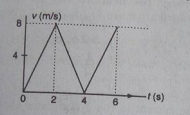If a freely falling body travels in the last second, a distance equal to the distance travelled by it in the first three second, the time of the travel is
A
6sec
B
5sec
C
4sec
D
3sec
Video Solution
Text Solution
The correct Answer is:B
Distance travel in last second
S_("lost") = g/2 (2n -1) = (9.8) (2n - 1)<br>Distancetravel∈1stthreesecond<br>S = 1/2 xx 9.8 xx (3)^2<br>(9.8)/(2) (2n - 1) =1/2 xx 9.8 xx (3)^2<br>rArr n = 5
|
Updated on:21/07/2023
Topper's Solved these Questions
- BOOK - ERRORLESSCHAPTER - MOTION IN ONE DIMENSIONEXERCISE - PAST YEARS QUESTIONS26videos
MOTION IN ONE DIMENSION
- BOOK - ERRORLESSCHAPTER - MOTION IN ONE DIMENSIONEXERCISE - ASSERTION AND REASON24videos
MOTION IN ONE DIMENSION
- BOOK - ERRORLESSCHAPTER - MOTION IN ONE DIMENSIONEXERCISE - NCERT BASED QUESTIONS (RELATIVE MOTION )18videos
MOTION IN ONE DIMENSION
- BOOK - ERRORLESSCHAPTER - KINETIC THEORY OF GASES EXERCISE - ASSERTION AND REASON16videos
KINETIC THEORY OF GASES
- BOOK - ERRORLESSCHAPTER - MOTION IN TWO DIMENSIONEXERCISE - ASSERTION & REASON19videos
MOTION IN TWO DIMENSION
Similar Questions
Knowledge Check
- Question 1 - Select One
The distance travelled by the moving body is :
AThe area between the speed time graph and time axis.BThe area between the speed time graph and speed axisCThe area between the distance time graph and time axisDThe area between the distance time graph and distance axis - Question 2 - Select One
If wavelength is equal to the distance travelled by the electron in one second , then :
Aλ=h/pBλ=h/mCλ=√h/pDλ=√h/m - Question 3 - Select One
If wavelength is equal to the distance travelled by the electron in one second then
Aλ=h/pBλ=h/mCλ=√h/pDλ=√h/m
A stone falls freely rest. The distance covered by it in the last second is equal to the distance covered by it in the first 2 s. The time taken by the stone to reach the ground is
View SolutionDistance travelled in nth second has the units of
View SolutionA freely falling body travelled x m in nth second. Then distance travelled in n−1th second is
View SolutionA stone falls freely such that the distance covered by it in the last second of its motion is equal to the distance covered by it in the first 5 seconds. It remained in air for :-
View SolutionThe v-t graph for a particle is as shown. The distance travelled in the first seconds is :
 View Solution
View Solution

